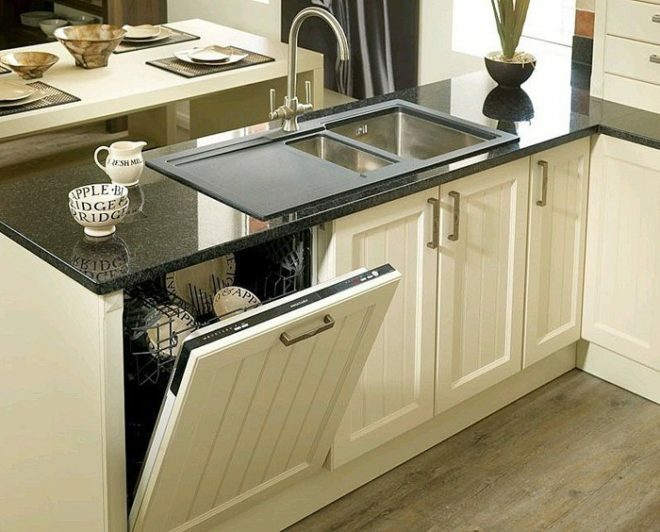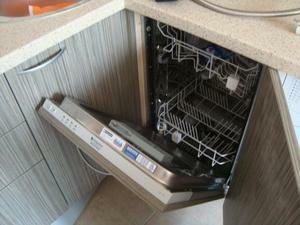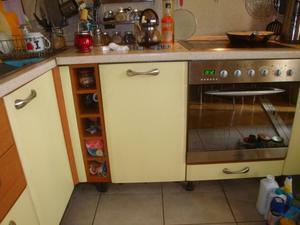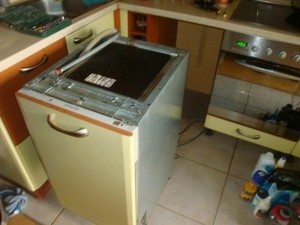 The dishwasher helps many housewives to get rid of unloved work, while saving personal time. Having bought furniture, the question arises, how to integrate the dishwasher into the countertop and can you install it yourself?
The dishwasher helps many housewives to get rid of unloved work, while saving personal time. Having bought furniture, the question arises, how to integrate the dishwasher into the countertop and can you install it yourself?
The advantages of the technology are that the consumption of water with a dishwasher becomes several times less, and with the current tariffs for utilities it is very profitable. In addition, after several years of operation, the cost of this unit will fully pay off.
Attention! Earned on our website kitchen designer. You can familiarize yourself with it and design your dream kitchen for free! May also come in handy wardrobes designer.

Varieties of dishwashers
Dishwashers are divided into three types: built-in, tabletop and freestanding.
- Tabletop machines are the smallest models that can be installed directly on the tabletop.
- Freestanding machines can be mounted in a kitchen set or as a separate module. It is enough to connect them to communications and electricity.
- Built-in models are suitable for a small kitchen, as they save space. Despite the fact that it is much more difficult to install and connect them to communications than previous devices, they have a great advantage. The general aesthetics of the interior of the room is not violated, since the dishwasher is hidden by part of the box of the kitchen set.
Where is the dishwasher installed in the finished kitchen?
 Before you install the clipper, you need to find a suitable place for it. The main thing is that the water supply and sewerage systems are located next to the equipment, and the heating system is far away, since the effect of heat can harm it. Typically, a built-in dishwasher is installed under the countertop. The device is manufactured with a standard and non-standard type of attachment.
Before you install the clipper, you need to find a suitable place for it. The main thing is that the water supply and sewerage systems are located next to the equipment, and the heating system is far away, since the effect of heat can harm it. Typically, a built-in dishwasher is installed under the countertop. The device is manufactured with a standard and non-standard type of attachment.
- When installing appliances with non-standard fasteners in a finished kitchen, you should carefully study the passport. The passport indicates which type of fastening is suitable for this box design.
- Niches in modern kitchen furniture are equipped for built-in appliances with standard fixings.
How do I install a freestanding dishwasher under a countertop? We select the section where the equipment will be installed, remove the shelves and disassemble it. If necessary, using a screwdriver, the strips for fastening inside the box can be rearranged to another place.
Basic installation rules
A standard built-in dishwasher is 550 mm deep, 450 to 600 mm wide, and 820 mm high. A simple DIY installation guide is included with each model. But you still need to know the basic rules:
- There must be a space for air behind the back wall of the device - at least 50 mm.
- Manufacturers of built-in dishwashers subtract a few millimeters from standard furniture sizes so that they do not have to change their size and shape. Boxes are made with a small margin, which are intended for built-in appliances.
- You can find out in what places holes for decorative box doors should be made using special templates that are indicated in the installation diagrams.
- It should be borne in mind that there is a control panel on the side of the machine.
- The height-adjusting feet will help to correctly position the built-in dishwasher at the desired level and fit it tightly to the basket.
- With the help of the mounting angles included in the kit, the device is rigidly fixed to the box with screws.
How to install an embedded dishwasher with your own hands
 Installation in a finished kitchen is a laborious process. Not everyone knows all the subtleties and installation rules. But by doing the installation yourself, without hiring a specialist, you can save money. For this, the instructions for installing equipment, which are attached to each model, will help. The dishwasher is selected in accordance with the depth and width of the kitchen unit.
Installation in a finished kitchen is a laborious process. Not everyone knows all the subtleties and installation rules. But by doing the installation yourself, without hiring a specialist, you can save money. For this, the instructions for installing equipment, which are attached to each model, will help. The dishwasher is selected in accordance with the depth and width of the kitchen unit.
For installation, you will need the following materials and tools:
- Screwdriver set, gas wrench and pliers.
- Roulette and building level.
- Hose for draining and supplying cold water (usually supplied).
- Sewer tee and drainage connection.
- Euro socket and cable with a cross-section of 1.5 mm (three-core).
- Corrugation, nipple, angle faucet and adapter.
- Angle, metal clamp, three-way valve.
- Siphon, water filter, aquastop system - if not present in the machine.
- Tow and fasteners.
Electrical connection
The first thing to do is to ground the outlets in the apartment if they are not grounded. A specialist is called for this work. Typically, in multi-storey buildings, the ground wire is connected to a dead neutral line. It is not possible to connect the machine to a simple outlet, therefore another one is installed at a height of 250–350 mm from the floor. To connect equipment, only euro sockets are used. They are equipped with a safety earth conductor. A 16 Amp breaker is used to draw off the equipment socket from the main contact connection.
To ensure that the electrical appliance is safe during operation and its warranty period does not disappear, it is impossible to independently replace the standard plug on the wire with another model.
Water connection
 It is not difficult to connect the device to the water supply. This can be done in several ways. The easiest and fastest option is to connect the tide hose directly to the sink tap in the kitchen. The disadvantage of such a connection: externally, the tap with the hose looks ugly and the tap cannot be used while the machine is running. Despite the fact that this method of connection is not very convenient, it can be used as a temporary one. The second option is more complex, but much better:
It is not difficult to connect the device to the water supply. This can be done in several ways. The easiest and fastest option is to connect the tide hose directly to the sink tap in the kitchen. The disadvantage of such a connection: externally, the tap with the hose looks ugly and the tap cannot be used while the machine is running. Despite the fact that this method of connection is not very convenient, it can be used as a temporary one. The second option is more complex, but much better:
- To connect the machine, you need to install a branch with a tap. To do this, use a plastic or metal tee with an angle tap. It is installed on a plumbing pipe. It is good if the tee is equipped with a built-in ball valve.
- The dishwasher is supplied with a tide hose, which is connected to the branch. If rigid pipes are used instead of a hose, then a filter is installed in front of the stopcock. Otherwise, a blockage will form on the heating part of the machine, which will lead to its breakdown.
How is the dishwasher integrated into the kitchen if several devices are connected to the water supply (washing machine, filters and taps)? In this case, install a manifold. With one manifold, the number of tapping into the main pipe will be reduced.
Trying to save money, some consumers connect the dishwasher to the hot water system. You should not do this, as from 5 to 10 liters of water is consumed per one working cycle of the machine, which is much more expensive. In addition, due to hot water, a breakdown of the check valve can occur, since it contains many different impurities.
Sewer connection
 To prevent the dishwasher from failing due to an incorrect connection to the sewer, you need to know some subtleties. Sometimes, if the connection is incorrect, all the water from the machine goes into the sewer and the equipment breaks down. Or, unpleasant odors from the sewer get into the camera of the device. To prevent all this from happening, you need to know how to properly connect the equipment. There are two ways: with the installation of a siphon or with the use of an oblique tee.
To prevent the dishwasher from failing due to an incorrect connection to the sewer, you need to know some subtleties. Sometimes, if the connection is incorrect, all the water from the machine goes into the sewer and the equipment breaks down. Or, unpleasant odors from the sewer get into the camera of the device. To prevent all this from happening, you need to know how to properly connect the equipment. There are two ways: with the installation of a siphon or with the use of an oblique tee.
- The most reliable and safest way to connect is with the installation of a siphon. It is he who protects the device from the ingress of sewage odors and eliminates the occurrence of the siphon effect. The usual siphon installed under the kitchen sink is replaced with another siphon model, which has one or two additional pipes. Next, the drain hose is connected to an additional outlet so that there are no kinks. Otherwise, the pump of the device may break. Strengthen the connecting place with a metal clamp.
- Connecting using a side tee is not the best option. But sometimes he becomes the only one. This method is used if the sink is far from the connected equipment. To prevent additional stress on the drain pump, do not lengthen the drain hose. Therefore, a tee is cut into the sewer pipe (choose the closest place to the equipment). Then a drain hose is connected to the tee. To prevent sewage contents from entering the working chamber of the machine, the hose is made up and down. An additionally installed anti-siphon valve will protect the equipment from the siphon effect.
Mounting the cabinet in the kitchen countertop
When the connection work is completed, the machine must be level. The leveling feet will help to adjust the position. Then, the detergent is poured into the apparatus without loading the dishes and a test run is carried out. Checking will show:
- At what speed is the flood of water.
- Heating level.
- Drying degree.
- Water is completely drained or not.
 In case of leaks, the nuts must be tightened or additionally rewound with FUM tape. If everything works well, the dishwasher is built into the furniture set. A decorative facade is installed to the door of the apparatus, which will hide the machine externally. The facade is fastened according to the scheme, which is indicated on the special templates supplied with the machine. The decorative door or panel is fixed to the machine body with fasteners.
In case of leaks, the nuts must be tightened or additionally rewound with FUM tape. If everything works well, the dishwasher is built into the furniture set. A decorative facade is installed to the door of the apparatus, which will hide the machine externally. The facade is fastened according to the scheme, which is indicated on the special templates supplied with the machine. The decorative door or panel is fixed to the machine body with fasteners.
How it fits in: expert advice
The dishwasher will last a long time and reliably without accidents, if you take into account some of the recommendations of experts:
- The dishwasher and countertop must be on the same level.
- In order for the kitchen set to serve for a long time, the walls inside the furniture case are pasted over with a vapor barrier.
- The furniture body must be strong if its bottom is a support for the apparatus.
- Place the dishwasher away from the electric oven or under the hob.
- The metal plate will protect the countertop well from steam.
- Under heavy load, the pressure pump will not work well, so the length of the drain hose should be no more than 2.5 m.
- You cannot connect equipment through extension cords.
- It is necessary to install and connect equipment with all responsibility, since it runs on electricity and there is water. And this is not safe!
- To avoid electric shock, it must be grounded.
Video: Installing an Integrated Dishwasher
average rating 0 / 5. Number of ratings: 0
No ratings yet. Be the first to rate.